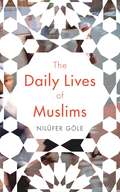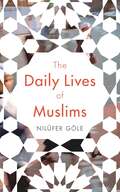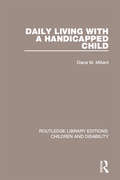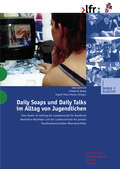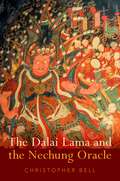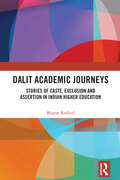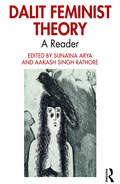- Table View
- List View
Daily Life of Women in Chaucer's England (The Greenwood Press Daily Life Through History Series)
by Jennifer C. EdwardsProviding an indispensable resource for students and scholars studying the history of medieval women and gender, this book provides a comprehensive depiction of women's lives in the 14th and 15th centuries.The late medieval period in England was one rich with opportunities for women, who played fundamental roles in family businesses as well as in the peasant community and economy, and who wrote letters, created autobiographies, and documented their spiritual journeys. Their lives fit into a pattern of seasonal celebrations and rituals shaped, for the majority of women, by work, marriage, and motherhood. The text further considers status distinctions, then shifts to experiences that affected all women, such as the ritual year, disease, food and drink, sex or celibacy, and religion.By providing an overview of the history of English women and gender in the 14th and 15th centuries, the book provides a background suitable for students as well as for academics beginning work in this field.
Daily Life of Women in Medieval Europe (The Greenwood Press Daily Life Through History Series)
by Belle S. TutenThis book is an introduction to the everyday lives of medieval European women: how they ate and slept, what their work was like, and the many factors that shaped their experiences.Ordinary people are often hard to see in the historical record. This resource for students reveals the everyday world of the Middle Ages for women: sex, marriage, work, and power. Using up-to-date scholarship from both archeology and history, this book covers major daily concerns for medieval people, their understanding of the world, their relationships with others, and their place in society. It attempts to clarify what we know and what we do not know about women's daily lives in the Western European Middle Ages, between approximately 500 and 1500 CE.The book's focus is everyday life, so the topics are organized around women's chores, expectations, and difficulties, especially with regard to sexuality and childbirth. In addition to broad survey information about the Middle Ages, the book also introduces major women writers and thinkers and provides some examples of their work, giving the reader an opportunity to engage with the women themselves.
Daily Life of Women in Medieval Europe (The Greenwood Press Daily Life Through History Series)
by Belle S. TutenThis book is an introduction to the everyday lives of medieval European women: how they ate and slept, what their work was like, and the many factors that shaped their experiences.Ordinary people are often hard to see in the historical record. This resource for students reveals the everyday world of the Middle Ages for women: sex, marriage, work, and power. Using up-to-date scholarship from both archeology and history, this book covers major daily concerns for medieval people, their understanding of the world, their relationships with others, and their place in society. It attempts to clarify what we know and what we do not know about women's daily lives in the Western European Middle Ages, between approximately 500 and 1500 CE.The book's focus is everyday life, so the topics are organized around women's chores, expectations, and difficulties, especially with regard to sexuality and childbirth. In addition to broad survey information about the Middle Ages, the book also introduces major women writers and thinkers and provides some examples of their work, giving the reader an opportunity to engage with the women themselves.
Daily Life of Women in Postwar America (The Greenwood Press Daily Life Through History Series)
by Nancy HendricksFrom Beatniks to Sputnik and from Princess Grace to Peyton Place, this book illuminates the female half of the U.S. population as they entered a "brave new world" that revolutionized women's lives.After World War II, the United States was the strongest, most powerful nation in the world. Life was safe and secure—but many women were unhappy with their lives. What was going on behind the closed doors of America's "picture-perfect" houses?This volume includes chapters on the domestic, economic, intellectual, material, political, recreational, and religious lives of the average American woman after World War II. Chapters examine topics such as the entertainment industry's evolving concept of womanhood; Supreme Court decisions; the shifting idea of women and careers; advertising; rural, urban, and suburban life; issues women of color faced; and child rearing and other domestic responsibilities.A timeline of important events and glossary help to round out the text, along with further readings and a bibliography to point readers to additional resources for their research. Ideal for students in high school and college, this volume provides an important look at the revolutionary transformation of women's lives in the decades following World War II.
Daily Life of Women in Postwar America (The Greenwood Press Daily Life Through History Series)
by Nancy HendricksFrom Beatniks to Sputnik and from Princess Grace to Peyton Place, this book illuminates the female half of the U.S. population as they entered a "brave new world" that revolutionized women's lives.After World War II, the United States was the strongest, most powerful nation in the world. Life was safe and secure—but many women were unhappy with their lives. What was going on behind the closed doors of America's "picture-perfect" houses?This volume includes chapters on the domestic, economic, intellectual, material, political, recreational, and religious lives of the average American woman after World War II. Chapters examine topics such as the entertainment industry's evolving concept of womanhood; Supreme Court decisions; the shifting idea of women and careers; advertising; rural, urban, and suburban life; issues women of color faced; and child rearing and other domestic responsibilities.A timeline of important events and glossary help to round out the text, along with further readings and a bibliography to point readers to additional resources for their research. Ideal for students in high school and college, this volume provides an important look at the revolutionary transformation of women's lives in the decades following World War II.
Daily Life through Trade: Buying and Selling in World History (The Greenwood Press Daily Life Through History Series)
by James M. AndersonTrade has long been—and will continue to be—a driving force that shapes our world. This book documents the tremendous importance of trade throughout history and its influence toward peaceful coexistence among nations.From ancient to modern times, trade has played an integral role in connecting disparate cultures and places on the earth—indeed, the existence of commercial trade across human civilization means that "globalization" is hardly a recent phenomenon or trend. Daily Life through Trade: Buying and Selling in World History documents how the importance of trade has made it the catalyst for migration, exploration, cultural interchange, and unfortunately, conflict and war throughout history.Author James M. Anderson describes the history of trade and traders' lives, examining how commerce had important consequences in various regions of the world and addressing a wide range of topics, such as fair trade, the World Trade Organization, and the role of trade in sparking world wars. The book's coverage ranges from the earliest times to the present day, and serves not only as an excellent general reference for history students and general readers, but also as valuable supplementary reading for those enrolled in courses in economics and business.
Daily Life through Trade: Buying and Selling in World History (The Greenwood Press Daily Life Through History Series)
by James M. AndersonTrade has long been—and will continue to be—a driving force that shapes our world. This book documents the tremendous importance of trade throughout history and its influence toward peaceful coexistence among nations.From ancient to modern times, trade has played an integral role in connecting disparate cultures and places on the earth—indeed, the existence of commercial trade across human civilization means that "globalization" is hardly a recent phenomenon or trend. Daily Life through Trade: Buying and Selling in World History documents how the importance of trade has made it the catalyst for migration, exploration, cultural interchange, and unfortunately, conflict and war throughout history.Author James M. Anderson describes the history of trade and traders' lives, examining how commerce had important consequences in various regions of the world and addressing a wide range of topics, such as fair trade, the World Trade Organization, and the role of trade in sparking world wars. The book's coverage ranges from the earliest times to the present day, and serves not only as an excellent general reference for history students and general readers, but also as valuable supplementary reading for those enrolled in courses in economics and business.
Daily Lives of Civilians in Wartime Africa: From Slavery Days to Rwandan Genocide (The Greenwood Press Daily Life Through History Series: Daily Lives of Civilians during Wartime)
by John Paul Ph.D.In most accounts of warfare, civilians suffer cruelties and make sacrifices silently and anonymously. This volume details the dismal impact war has had on the African people over the past five hundred years, from slavery days, the Zulu War, World Wars I and II, to the horrific civil wars following decolonization and the genocide in Rwanda.In most accounts of warfare, civilians suffer cruelties and make sacrifices silently and anonymously. Finally, historians turn their attention to those who are usually caught up in events beyond their control or understanding. This volume details the dismal impact war has had on the African people over the past five hundred years, from slavery days, the Zulu War, World Wars I and II, to the horrific civil wars following decolonization and the genocide in Rwanda. Chapters provide a representative range of civilian experiences during wartime in Africa extending from the late eighteenth century to the present, representing every region of Africa except North Africa. Timelines, glossaries, suggested further readings and maps are included, and the work is fully indexed.The book begins with Paul E. Lovejoy's study of the ubiquitous experience of African slavery which has so profoundly affected the development of the continent and the lives of its people. John Laband then examines the rise of the Zulu kingdom in the early nineteenth century and its subsequent conquest by Britain, thus charting the fate of civilians during the formation of an African kingdom and their experiences during colonial conquest. The Anglo-Boer War is situated at a crucial crossroads between colonial and modern warfare, and the concentration camps the British set up for Boer and African civilians pioneered a new form of modern savagery. Bill Nasson examines this war's complex effects on various categories of non-combatants in South Africa. Because it was under colonial rule, Africa was dragged into the two World Wars. Tim Stapleton shows in the fourth chapter that while the African civilian response to the war of 1914-1918 was often contradictory and ranged from collaboration to revolt, the effect of the conflict was only to confirm colonial rule. In the following chapter, David Killingray explains how and why the impact of the Second World War on African civilians was rather different from that of the First in that it undid colonial rule, and paved the way for the future independence of Africa under modernized African leadership. The Portuguese held on to their African empire long after the other colonial empires had relinquished theirs in the 1960s. Angola, the subject of Chapter six, passed seamlessly out of an independence struggle against Portuguese rule into civil war that soon involved Cold War rivalries and interventions. Inge Brinkman describes the dismal sufferings and displacement of Angolan civilians during four decades of interminable fighting. Liberia and Sierra Leone declined from relative stability and prosperity into horrific civil war, and in Chapter seven Lansana Gberie traces the deadly consequences for civilians and the efforts to stabilize society once peace was tentatively restored. The Sudan has suffered decades of ethnic and religious strife between the government and the people of the southern and western periphery, and in Chapter eight Jane Kani Edward and Amir Idris analyze what this has meant, and still means, for the myriad civilian victims. Chapter nine concludes the book with the most horrific single episode of recent African history: the Rwandan genocide. Alhaji Bah explains its genesis and canvasses the subsequent search for reconciliation. The chapter ends with his discussion of African mechanisms that should - and even might - be put in place to ensure effective peacekeeping in Africa, and so save civilians in future from the swarm of war's horrors.
The Daily Lives of Muslims: Islam and Public Confrontation in Contemporary Europe
by Nilüfer GöleFor many in the West, Islam has become a byword for terrorism. From 9/11 to the Paris attacks, our headlines are dominated by images of violence and extremism. Now, as the Western world struggles to cope with the refugee crisis, there is a growing obsession with the issue of Muslim integration. Those Muslims who fail to assimilate are branded the 'enemy within', with their communities said to provide a fertile breeding ground for jihadists. Such narratives, though, fail to take into account the actual lives of most Muslims living in the West, fixating instead on a minority of violent extremists.In The Daily Lives of Muslims, Nilüfer Göle provides an urgently needed corrective to this distorted image of Islam. Engaging with Muslim communities in twenty-one cities across Europe where controversies over integration have arisen – from the banning of the veil in France to debates surrounding sharia law in the UK – the book brings the voices of this neglected majority into the debate. In doing so, Göle uncovers a sincere desire among many Muslims to participate in the public sphere, a desire which is too often stifled by Western insecurity and attempts to suppress the outward signs of religious difference.
The Daily Lives of Muslims: Islam and Public Confrontation in Contemporary Europe
by Nilüfer GöleFor many in the West, Islam has become a byword for terrorism. From 9/11 to the Paris attacks, our headlines are dominated by images of violence and extremism. Now, as the Western world struggles to cope with the refugee crisis, there is a growing obsession with the issue of Muslim integration. Those Muslims who fail to assimilate are branded the 'enemy within', with their communities said to provide a fertile breeding ground for jihadists. Such narratives, though, fail to take into account the actual lives of most Muslims living in the West, fixating instead on a minority of violent extremists.In The Daily Lives of Muslims, Nilüfer Göle provides an urgently needed corrective to this distorted image of Islam. Engaging with Muslim communities in twenty-one cities across Europe where controversies over integration have arisen – from the banning of the veil in France to debates surrounding sharia law in the UK – the book brings the voices of this neglected majority into the debate. In doing so, Göle uncovers a sincere desire among many Muslims to participate in the public sphere, a desire which is too often stifled by Western insecurity and attempts to suppress the outward signs of religious difference.
Daily Living with a Handicapped Child (Routledge Library Editions: Children and Disability)
by Diana M. MillardFirst published in 1984, this book focuses on the support and reassurance needed by parents of children with handicaps. It provides a practical guide in relation to daily care and is equally as relevant to professionals, therapists, teachers, doctors and psychologists who must advise parents. Written by an Occupational Therapist, the book highlights the need to make such children as independent as possible and gives advice on care of a special baby, modifications to the home environment, the needs of a child with a physical handicap, problems of educational handicap, and the place of a child in the family and community.
Daily Living with a Handicapped Child (Routledge Library Editions: Children and Disability #11)
by Diana M. MillardFirst published in 1984, this book focuses on the support and reassurance needed by parents of children with handicaps. It provides a practical guide in relation to daily care and is equally as relevant to professionals, therapists, teachers, doctors and psychologists who must advise parents. Written by an Occupational Therapist, the book highlights the need to make such children as independent as possible and gives advice on care of a special baby, modifications to the home environment, the needs of a child with a physical handicap, problems of educational handicap, and the place of a child in the family and community.
Daily Soaps und Daily Talks im Alltag von Jugendlichen: Eine Studie im Auftrag der Landesanstalt für Rundfunk Nordrhein-Westfalen und der Landeszentrale für private Rundfunkveranstalter Rheinland Pfalz (Schriftenreihe Medienforschung der Landesanstalt für Medien in NRW #38)
by Udo Göttlich Friedrich Krotz Ingrid Paus-HasebrinkWas bieten die täglichen Soaps und Talkshows Jugendlichen? Wie gehen Jugendliche mit diesen Fernsehangeboten um? Welche Konsequenzen hat dabei das Format "Big Brother"? Das Buch führt Befunde aus verschiedenen Untersuchungsschritten zusammen und interpretiert diese im Hinblick auf die Bedeutung der Fernsehangebote für die Jugendkultur. Dabei werden auch die Online-Angebote zu Serien und Talkshows erfasst.
Daisy Wheel, Hexfoil, Hexafoil, Rosette: Protective Marks in Gravestone Art
by Robyn S. LacyThe use of protective symbols, also known as apotropaic marks, are often part of folk magic traditions, appearing in homes, churches, on personal items, and even graves, across Europe, Australia, and North America. The most common and well-known of these marks is the hexfoil, otherwise known as the daisy wheel, witch hex, or rosette. Hexfoils have a history of use for personal protection and were carved both intentionally or graffitied into church pews and walls, bed frames, doors, and gravestones. This research sheds light on the use of this historic symbol to protect the bodies and souls of the deceased, across several thousand years and multiple countries.
Daisy Wheel, Hexfoil, Hexafoil, Rosette: Protective Marks in Gravestone Art
by Robyn S. LacyThe use of protective symbols, also known as apotropaic marks, are often part of folk magic traditions, appearing in homes, churches, on personal items, and even graves, across Europe, Australia, and North America. The most common and well-known of these marks is the hexfoil, otherwise known as the daisy wheel, witch hex, or rosette. Hexfoils have a history of use for personal protection and were carved both intentionally or graffitied into church pews and walls, bed frames, doors, and gravestones. This research sheds light on the use of this historic symbol to protect the bodies and souls of the deceased, across several thousand years and multiple countries.
Daisy Wheel, Hexfoil, Hexafoil, Rosette: Protective Marks in Gravestone Art
by Robyn S. LacyThe use of protective symbols, also known as apotropaic marks, are often part of folk magic traditions, appearing in homes, churches, on personal items, and even graves, across Europe, Australia, and North America. The most common and well-known of these marks is the hexfoil, otherwise known as the daisy wheel, witch hex, or rosette. Hexfoils have a history of use for personal protection and were carved both intentionally or graffitied into church pews and walls, bed frames, doors, and gravestones. This research sheds light on the use of this historic symbol to protect the bodies and souls of the deceased, across several thousand years and multiple countries.
The Dalai Lama and the Nechung Oracle
by Christopher BellTibetan Buddhism and the Dalai Lama enjoy global popularity and relevance, yet the longstanding practice of oracles within the tradition is still little known and understood. The Nechung Oracle, for example, is believed to become possessed by an important god named Pehar, who speaks through the human medium to confer with the Dalai Lama on matters of state. The Dalai Lama and the Nechung Oracle is the first monograph to explore the mythologies and rituals of this god, the Buddhist monastery that houses him, and his close friendship with incarnations of the Dalai Lama over the centuries. In the seventeenth century, during the reign of the Fifth Dalai Lama, the protector deity Pehar and his oracle at Nechung Monastery were state-sanctioned by the nascent Tibetan government, becoming the head of an expansive pantheon of worldly deities assigned to protect the newly unified country. The governments of later Dalai Lamas expanded the deity's influence, as well as their own, by establishing Pehar at monasteries and temples around Lhasa and across Tibet. Pehar's cult at Nechung Monastery came to embody the Dalai Lama's administrative control in a mutual relationship of protection and prestige, the effects of which continue to reverberate within Tibet and among the Tibetan exile community today. The friendship between these two immortals has spanned nearly five hundred years across the Tibetan plateau and beyond.
The Dalai Lama and the Nechung Oracle
by Christopher BellTibetan Buddhism and the Dalai Lama enjoy global popularity and relevance, yet the longstanding practice of oracles within the tradition is still little known and understood. The Nechung Oracle, for example, is believed to become possessed by an important god named Pehar, who speaks through the human medium to confer with the Dalai Lama on matters of state. The Dalai Lama and the Nechung Oracle is the first monograph to explore the mythologies and rituals of this god, the Buddhist monastery that houses him, and his close friendship with incarnations of the Dalai Lama over the centuries. In the seventeenth century, during the reign of the Fifth Dalai Lama, the protector deity Pehar and his oracle at Nechung Monastery were state-sanctioned by the nascent Tibetan government, becoming the head of an expansive pantheon of worldly deities assigned to protect the newly unified country. The governments of later Dalai Lamas expanded the deity's influence, as well as their own, by establishing Pehar at monasteries and temples around Lhasa and across Tibet. Pehar's cult at Nechung Monastery came to embody the Dalai Lama's administrative control in a mutual relationship of protection and prestige, the effects of which continue to reverberate within Tibet and among the Tibetan exile community today. The friendship between these two immortals has spanned nearly five hundred years across the Tibetan plateau and beyond.
Dalit Academic Journeys: Stories of Caste, Exclusion and Assertion in Indian Higher Education
by Bharat RathodThis book provides a comprehensive overview of the academic journeys of Dalit students and their lived experiences of systemic exclusion in Indian higher education. It explains their educational journeys beyond caste-based discrimination, specifically analyzing the power dynamics, resilience, and resistance in their institutional life. The volume, — Describes institutional culture, practices and contexts that contribute to a negative environment for Dalit students, and what changes would be required to create a positive campus climate for them; — Provides a comparative analysis with the United States higher education contexts while drawing theoretical frameworks from critical race theory in educational settings, social reproduction theory and diversity research; — Discusses the significance of developing anti-casteist, democratic and inclusive university spaces in India, with an emphasis on how Indian university campuses can be transformed through diversity, equity, inclusion initiatives and indispensable support programs to assist Dalit and other vulnerable students; Nuanced and accessible, this book will be of interest to students, teachers and researchers of education, higher education, sociology, exclusion studies, and Dalit studies. It will also be useful for policymakers, social activists, NGOs, research centres and those working in the areas of higher education, reservations, public policy, caste, anti-caste and exclusion studies.
Dalit Academic Journeys: Stories of Caste, Exclusion and Assertion in Indian Higher Education
by Bharat RathodThis book provides a comprehensive overview of the academic journeys of Dalit students and their lived experiences of systemic exclusion in Indian higher education. It explains their educational journeys beyond caste-based discrimination, specifically analyzing the power dynamics, resilience, and resistance in their institutional life. The volume, — Describes institutional culture, practices and contexts that contribute to a negative environment for Dalit students, and what changes would be required to create a positive campus climate for them; — Provides a comparative analysis with the United States higher education contexts while drawing theoretical frameworks from critical race theory in educational settings, social reproduction theory and diversity research; — Discusses the significance of developing anti-casteist, democratic and inclusive university spaces in India, with an emphasis on how Indian university campuses can be transformed through diversity, equity, inclusion initiatives and indispensable support programs to assist Dalit and other vulnerable students; Nuanced and accessible, this book will be of interest to students, teachers and researchers of education, higher education, sociology, exclusion studies, and Dalit studies. It will also be useful for policymakers, social activists, NGOs, research centres and those working in the areas of higher education, reservations, public policy, caste, anti-caste and exclusion studies.
Dalit Cosmos: Understanding Caste, Marginalisation and Dalit Literature in India
by Mudnakudu ChinnaswamyThis book is a fierce argument against social and caste discrimination in India, especially untouchability and emphatic call for social justice. Written by a first-generation Kannada Dalit writer, the book provides an insider’s view of caste discrimination as the author has lived through and experienced it. It traces the roots of present-day activism against caste discrimination, the influence of Ambedkar, the rise of Hindutva, and the role of Dalit literatures in shaping discourses around caste in India. An invigorating collection of essays and speeches by Mudnakudu Chinnaswamy, this volume will be of great interest to scholars and researchers of discrimination, literature, politics and political philosophy, exclusion studies, race, social justice, cultural studies, and South Asian studies.
Dalit Cosmos: Understanding Caste, Marginalisation and Dalit Literature in India
by Mudnakudu ChinnaswamyThis book is a fierce argument against social and caste discrimination in India, especially untouchability and emphatic call for social justice. Written by a first-generation Kannada Dalit writer, the book provides an insider’s view of caste discrimination as the author has lived through and experienced it. It traces the roots of present-day activism against caste discrimination, the influence of Ambedkar, the rise of Hindutva, and the role of Dalit literatures in shaping discourses around caste in India. An invigorating collection of essays and speeches by Mudnakudu Chinnaswamy, this volume will be of great interest to scholars and researchers of discrimination, literature, politics and political philosophy, exclusion studies, race, social justice, cultural studies, and South Asian studies.
Dalit Counter-publics and the Classroom: A Sharmila Rege Reader
by Uma Chakravarti V. GeethaThis book is an anthology of the collected essays of Sharmila Rege (1964 – 2013) that addresses themes to do with pedagogy and culture. Rege makes a compelling argument for rethinking the content of sociological knowledge and invokes in this context, Anticaste radical philosophies, associated with Mahatma Phule and Babasaheb Ambedkar as well as the writings of Dalit women. Equally, she seeks to rethink and engender the domain of Cultural Studies. She calls attention to 'Dalit counter-publics', comprising performance and commemorative traditions that are committed to ending the caste order and argues for a critical rethinking of the relationship between caste, sexuality, and popular culture.Framed and annotated by an introduction that places Sharmila's work in the intellectual and historical contexts that shaped it, the volume also features short prefatory notes by her colleagues on the various themes taken up for discussion. Addressing, as it does, the researcher, the activist and the teacher, the book is indispensable for students and researchers of Women’s Studies, feminism, gender studies, Dalit Studies, minority studies, Sociology, Cultural Studies, Performance Studies, as well as studies in language and rhetoric.
Dalit Counter-publics and the Classroom: A Sharmila Rege Reader
This book is an anthology of the collected essays of Sharmila Rege (1964 – 2013) that addresses themes to do with pedagogy and culture. Rege makes a compelling argument for rethinking the content of sociological knowledge and invokes in this context, Anticaste radical philosophies, associated with Mahatma Phule and Babasaheb Ambedkar as well as the writings of Dalit women. Equally, she seeks to rethink and engender the domain of Cultural Studies. She calls attention to 'Dalit counter-publics', comprising performance and commemorative traditions that are committed to ending the caste order and argues for a critical rethinking of the relationship between caste, sexuality, and popular culture.Framed and annotated by an introduction that places Sharmila's work in the intellectual and historical contexts that shaped it, the volume also features short prefatory notes by her colleagues on the various themes taken up for discussion. Addressing, as it does, the researcher, the activist and the teacher, the book is indispensable for students and researchers of Women’s Studies, feminism, gender studies, Dalit Studies, minority studies, Sociology, Cultural Studies, Performance Studies, as well as studies in language and rhetoric.
Dalit Feminist Theory: A Reader
by Aakash Singh Rathore Sunaina AryaDalit Feminist Theory: A Reader radically redefines feminism by introducing the category of Dalit into the core of feminist thought. It supplements feminism by adding caste to its study and praxis; it also re-examines and rethinks Indian feminism by replacing it with a new paradigm, namely, that caste-based feminist inquiry offers the only theoretical vantage point for comprehensively addressing gender-based injustices. Drawing on a variety of disciplines, the chapters in the volume discuss key themes such as Indian feminism versus Dalit feminism; the emerging concept of Dalit patriarchy; the predecessors of Dalit feminism, such as Phule and Ambedkar; the meaning and value of lived experience; the concept of Difference; the analogical relationship between Black feminism and Dalit feminism; the intersectionality debate; and the theory-versus-experience debate. They also provide a conceptual, historical, empirical and philosophical understanding of feminism in India today. Accessible, essential and ingenious in its approach, this book is for students, teachers and specialist scholars, as well as activists and the interested general reader. It will be indispensable for those engaged in gender studies, women’s studies, sociology of caste, political science and political theory, philosophy and feminism, Ambedkar studies, and for anyone working in the areas of caste, class or gender-based discrimination, exclusion and inequality.






